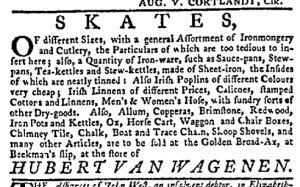What was advertised in a colonial American newspaper 250 years ago today?

“SKATES, OF different sizes.”
Hubert Van Wagenen sold a variety of goods – from “Ironmongery and Cutlery” to textiles and “sundry sorts of other Dry-goods” – at his store “at the Golden Broad-ax” in New York, but he highlighted one item in particular to attract the attention of potential customers: “SKATES, OF different sizes.” Van Wagenen enumerated his merchandise in a typical list advertisement, but he set apart “SKATES” as the only word on the first line, printed in a larger font so as to serve as a headline that invited readers to further explore his other wares.
By the late colonial period ice skating was a popular pastime in New England and the Middle Atlantic colonies, especially among the gentry. Along with dancing and fencing, skating allowed the better sorts to demonstrate grace, power, and agility. According to Nancy Struna, both men and women among the gentry and the middling sort aspiring to join the gentry “expected to play and display their prowess in such endeavors in the middle decades of the eighteenth century.”[1] To that end, they engaged in selected sports and other physical activities that simultaneously evoked pleasure and allowed them to demonstrate skill and discipline through their personal comportment. Physical improvement was as important an element of refinement as learning and manners.
Unlike some of his competitors, Van Wagenen did not make explicit appeals to gentility when describing any of the goods listed in his advertisement. He did not, for instance, use the word “fashionable” or underscore that he imported goods that reflected the latest tastes in London. He may not have considered any of that necessary. Realizing that readers likely considered skating a genteel leisure activity, the shopkeeper had an alternate means of associating gentility with his shop. By listing “SKATES” first and using them to headline his advertisement, he set the tone for how readers should imagine the housewares, textiles, and accessories he also sold.
**********
[1] Nancy L. Struna, People of Prowess: Sport, Leisure, and Labor in Early Anglo-America (Urbana: University of Illinois Press, 1996) 121.
